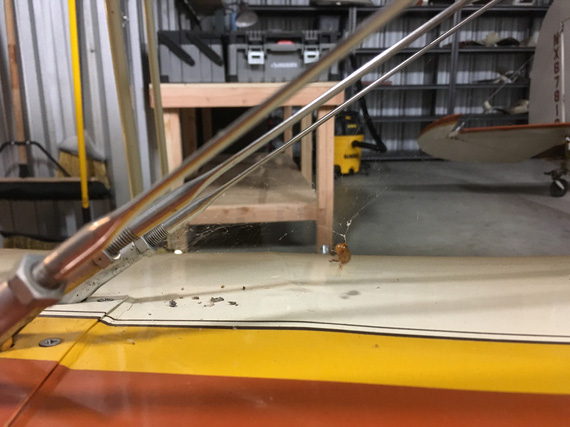[79FT]: Building Things |
 |
Electrical Disassembly
...fun with wires
| On: | Jul 01, 2019 |
| In: | [Chickenhouse Charger] Electrical Rebuild |
| Time logged: | 13.1 |
| Tags: | 6781G, MA5 Charger, electrical, soldering |
Well, all the electrical on the Charger is disassembled now. I logged about 24 hours doing it.

Firewall wire harness, looking into the side conduit
I have started with wires on the terminal block and in the side channel, and was moving back and forth between various locations - get bored in one, move on to the next.
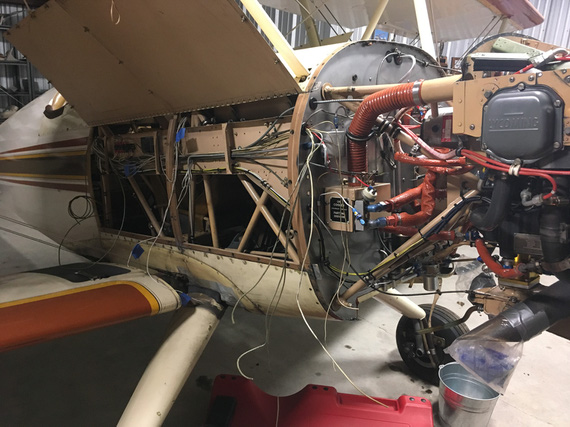
The disassembly has begun!
In the side conduit, going on the right side of the plane to the back cockpit, I was slowly removing the wires, and the oil and fuel pressure lines.
Had to be careful to mark the wires I wanted to keep - all the wires going to the lights, and some instruments in the front and back.
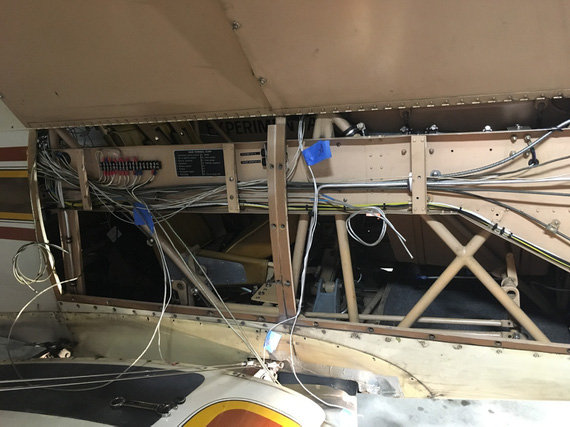
Wire by wire...
I would cut them off, and pull them out one by one.
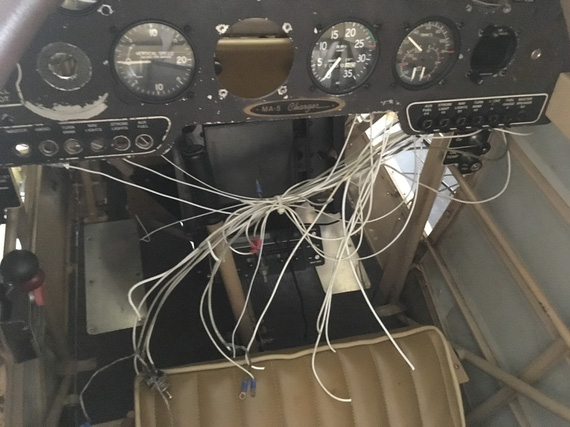
Behind the panel is a rat's nest!
I pulled the mechanical tach and it's cable, and the oil temp and pressure and fuel pressure gauge.
By the way, the oil temp gauge was unpowered! And still ran on a thermocouple - but it's huge, to generate enough power to move the needle.
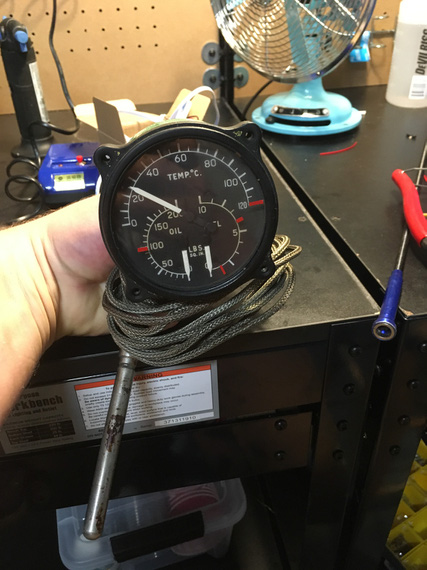
Old school!
Heck, I'm keeping it as my IHT Gauge!!! (Internal Hangar Temperature, that is). It just looks too cool.
Eventually, all the wires were gone from there, aside from the ones I'm keeping; and the ones I'm keeping got temporarily marked.
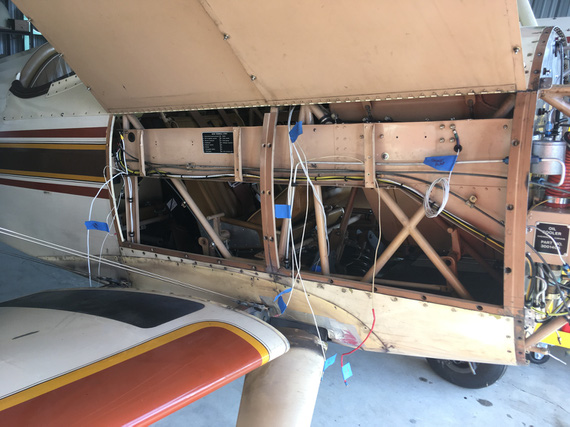
All done!
By the way, I found a burnt wire! Was one of the unfused wires going to the voltage regulator.

Burnt wire - can you see it?
I cut off the burnt chunk.
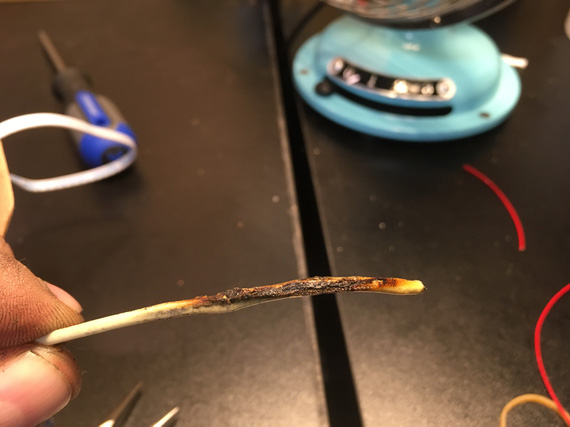
Front
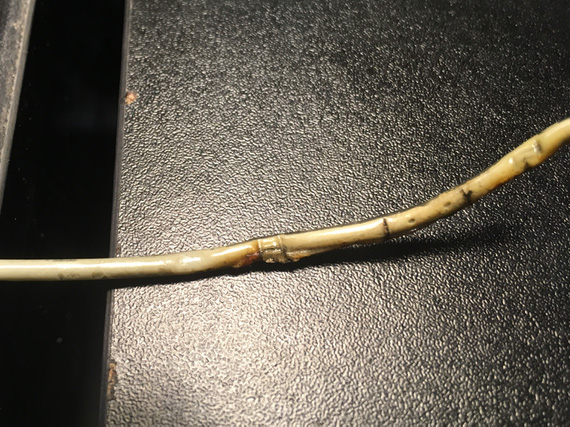
Back
See those little "boil bubbles" on the back side? Insulation was super brittle, and just a minor twist cracked it open.

Cracked
Meanwhile, behind the panel were a couple of soldered things - with wires unsupported. One of them was the master switch, the other one was this weird resistor in the voltage regulator circuit where the low voltage alarm light was supposed to be.. go figure.
But look at the solder joints:

Master Switch
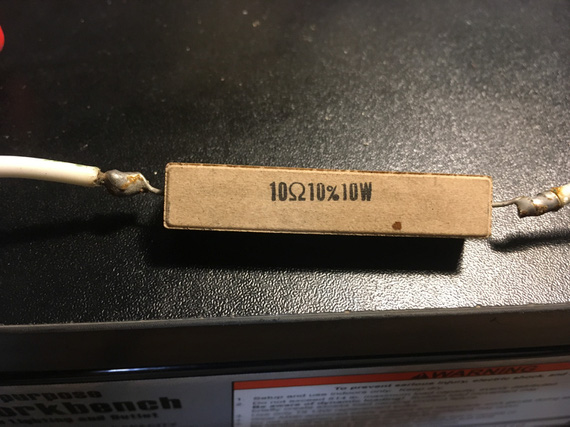
Resistor
Notice, they were not done very carefully (especially the ones on the Master Switch). Flux was not cleaned. But! The joints look, and are, solid. They are almost 40 years old.
I think I am officially now in the "no soldering on airplanes is an old wife's tale" camp.
At some point, I decided to take a break, and try on the new Voltage Regulator I'm planning on installing.
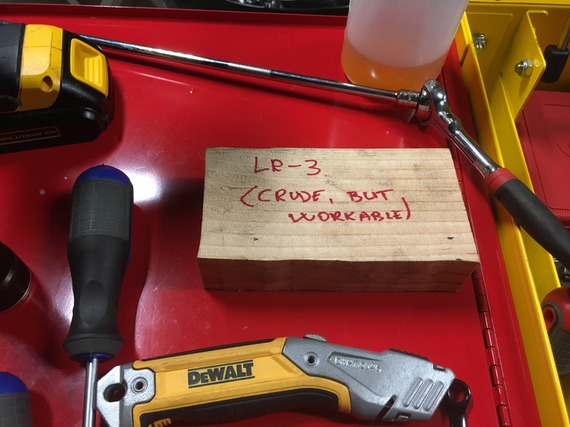
....it's not up to scale, and I did not have the time to paint it...
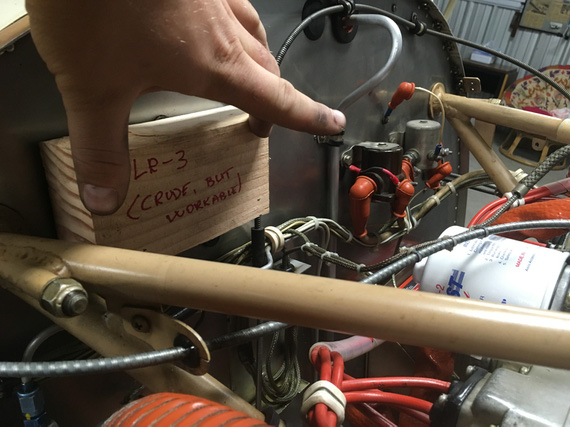
FWF location

Side Conduit location
I'm thinking I'm gonna mount it in that conduit on the side. It'll stay cooler, and generally be tidier. I'll use the space occupied by the old voltage regulator for my current limiters and the ammeter shunt, though still need to think a bit more about placement. Maybe those will go somewhere else, too.
By the way, the old voltage regulator in all it's glory:
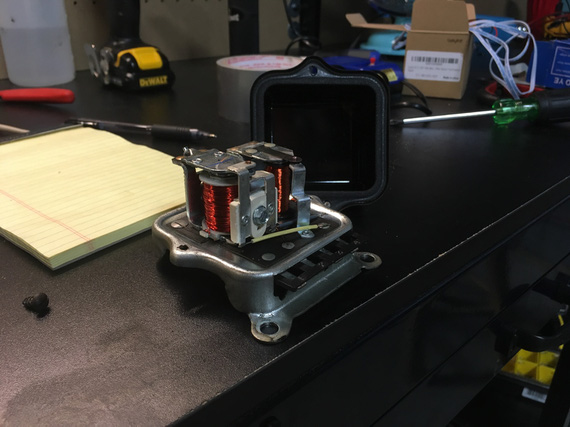
A Mechanical Switching Voltage Regulator
I also completely removed the strobe - I'll be replacing nav lights with SkyBeacon/SkySensor; which will cover my blinking needs.
Wanna see a couple old electrolytic caps? The strobe power supply still worked, by the way!
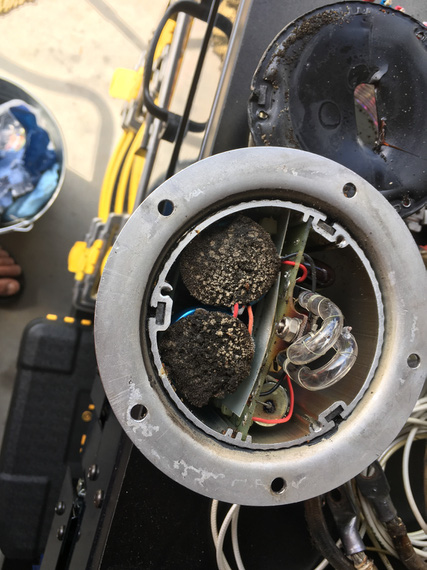
The Strobe power supply and bulb
I have disassembled the charging and starting circuits completely, too. Since I'm redoing everything anyway, adding better wires, and new terminals would not add too much expense, and be good for the system. I also want to modify how battery is grounded.
Found this next to the Master Contactor

Accidental welding on firewall
Do you see it? Two spots, above the screw? Someone didn't disconnect the cable when working on her! :). (And, no, that wasn't me)
And finally, here's how almost the entirety of electrical system looks like.
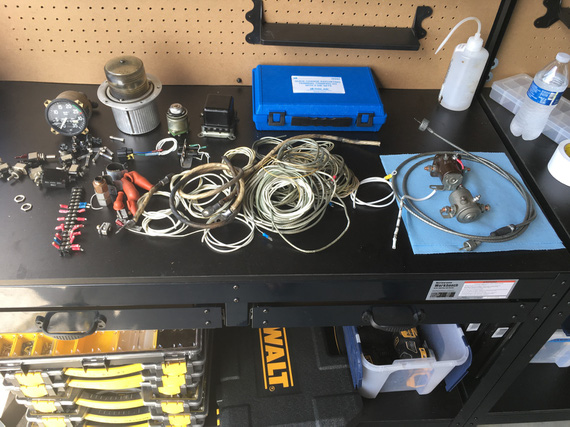
Most of the electrical of a biplane
Some swithces, some fuses, some wire, and that's it!
Try to keep the number of your landings equal to the number of your takeoffs.
Up ↑
Wire Markings, Fuselinks, Load Measurements, and Turn-and-Slip
tested fuselinks, measured loads, removed and diagnosed turn-and-slip indicator
| On: | Jun 18, 2019 |
| In: | [Chickenhouse Charger] Electrical Rebuild |
| Time logged: | 6.5 |
| Tags: | 6781G, MA5 Charger, electrical, experiments, research, instruments, soldering |
Finally, doing some actual work on the airplane, and having fun! And I decided to start logging time.. because, why not!
Wire Marking
I like marked wires. I used to be a networking guy, and I was very meticulous about marking every single wire in my cabinets, so that I knew exactly what was plugged in where.
It took a bit of upfront time, but saved a bunch of it later on.
So naturally, I was planning to do the same on the Charger, and, more importantly, make it look professional.
Thanks to living in this day and age, that is simple. No, I'm not gonna pay someone to laser etch my wires - that's a cop out :). It's like paying someone to paint your plane.
Instead, I have researched and found a perfect label maker - Brady BMP21 (not including a link here because it will probably go dead after some time... just search for it). This thing has 3:1 heatshrink tube cartridges.
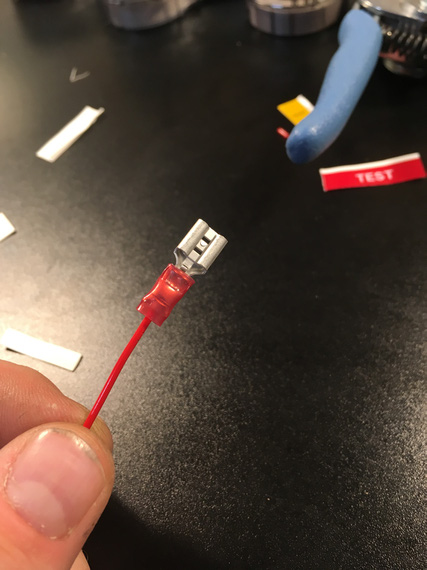
The proverbial coupon

Prior to shrinking
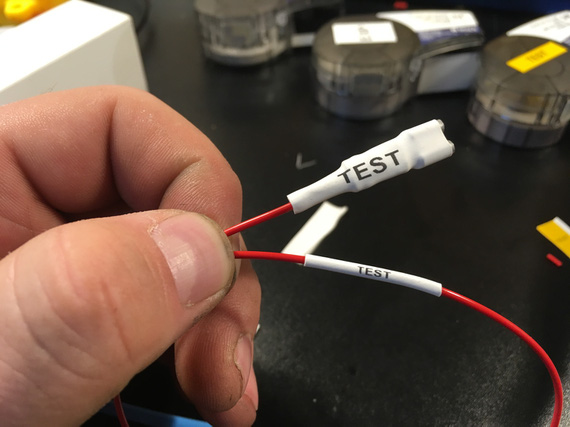
Shrunk!
Fusible Links
Every wire must be fused at the source. Well, almost every :). We don't fuse a couple wires like battery - master contactor: but this is an exception rather than the rule.
Most wires are fused on the fuse block at the main buss. But some wires are impractical or impossible to have hooked up to that. Think ammeter shunt wires as a classic example.
For those, most people use bulky, ugly, and generally eww-y inline fuses. But there's a better option! Enter fusible links.
The idea is simple: use a short length of wire 4 gauges smaller the wire to be fused. So if your wire to be fused is 20AWG, you would do:
Source -> 24AWG -> 20AWG where the 24AWG segment acts as a fuse. The idea is, in case of a short, that piece will burn first.
So, I wanted to convince myself that that will work fine for me.
Initially, me and my ham neighbor tried to use his ~30 amp power supply to do it. No joy. The best we could do is 22 amps, and (imagine that!) 24 gauge we were trying to burn held up to the abuse with no sweat at all! I could even hold it in my fingers. Yay, milspec wire!
So I decided to go rough. I do have a discarded old battery, after all. It was time to burn some wires with it.
Here, the red wire is 20AWG, and the black wire is 24AWG. Using crimps for quick setup.
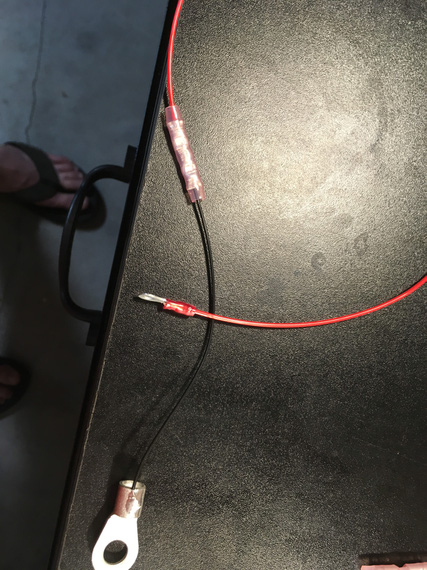
The link
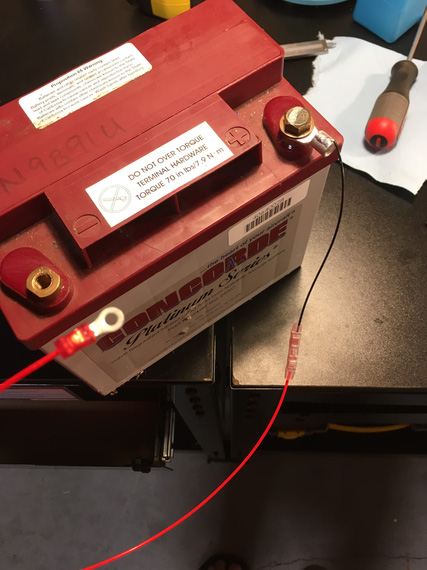
The hookup

Boom!
It burnt real quick, in less than a second, and the protected (red) wire barely got hot (I was holding it - that was a part of the test). Yes, say that I am unscientific all you want - milspec wire holds up to 150C, and I can't hold up to 150C. The 20GA wire got barely warm - which means it won't cause any problems in a bundle.
It worked!
Now, it was time to set up a real one - to make sure that when the "fuse" wire burns, it doesn't damage anything.
B&C sells very nice fiberglass tubing covered in silicone for exactly this purpose.
I also soldered the fuselink in this time - I wanted to see how well will the solder splices hold to the temps.
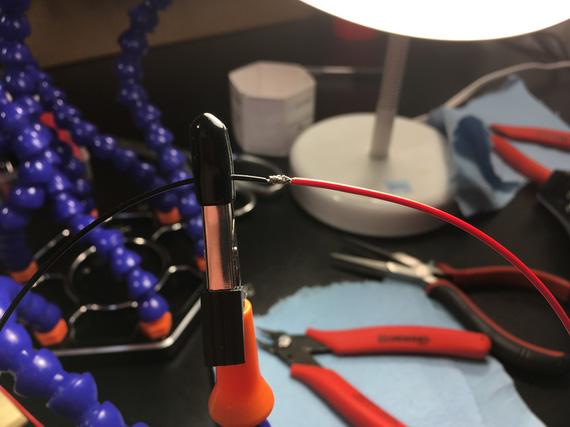
Soon to be splice

24AWG spliced into 20AWG
Note here: I know that in reality, the thin 24AWG wire will be the first in chain; here I'm just splicing it in the middle of 20AWG segment so that I can cover both ends. In "production" fuse links, the "source" end will be a ring terminal, and the fiberglass sleeve will go over it.
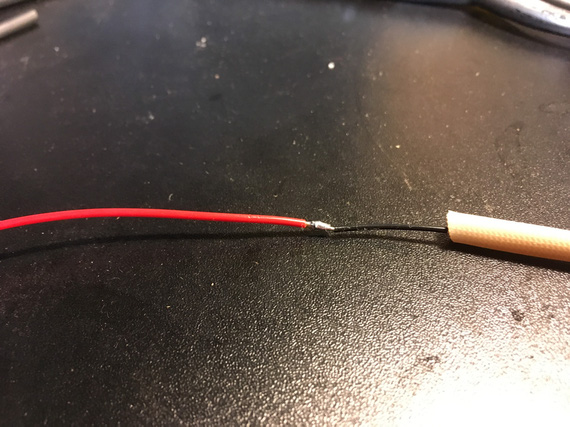
Sleeve on

With heatshrink

Ready to go!
Boom! Or not? I thought it didn't work, frankly. I didn't hear anything. I didn't smell anything. I actually took my multimeter to make sure the continuity wasn't there - it wasn't!!! Wow. The fiberglass sleeve contained the micro-explosion really well.
I took it off to inspect.
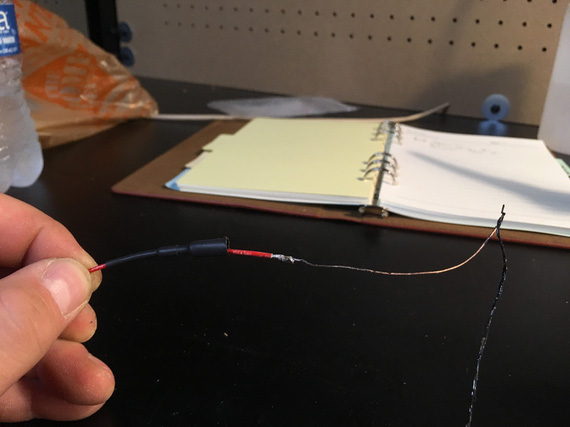
All burnt up wire
The fiberglass sleeve showed no signs of damage.
Great success!
I will need to play with different sizes of heatshrink and probably will use the glue lined strain relief kind just to support everything well, but hey - this worked very well indeed!
Load Measurements
Prior to ripping the old wiring out, I wanted to take some real life load measurements with various things turned on, so that I don't get any nasty surprises.
But this plane has no ammeter... damn. I searched around, and found this little doodad:
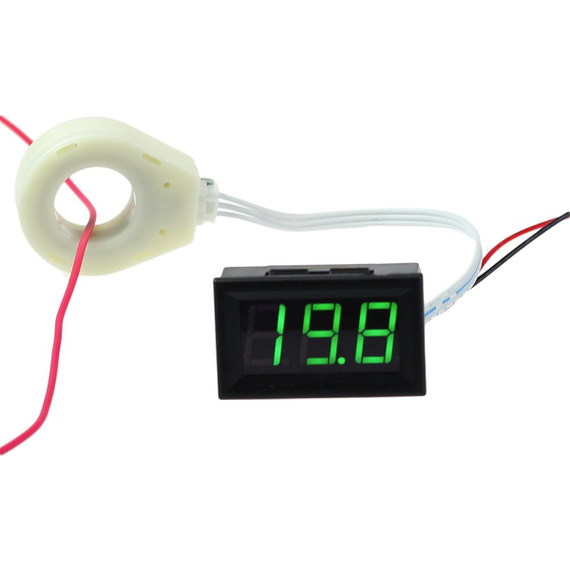
Hall Effect ammeter
Very nice. It basically measures current on the wire passing thru this big white ring using Hall effect. Very cool! No need to splice into the battery leads and install a temp shunt.
So, I rigged it up and took some numbers.
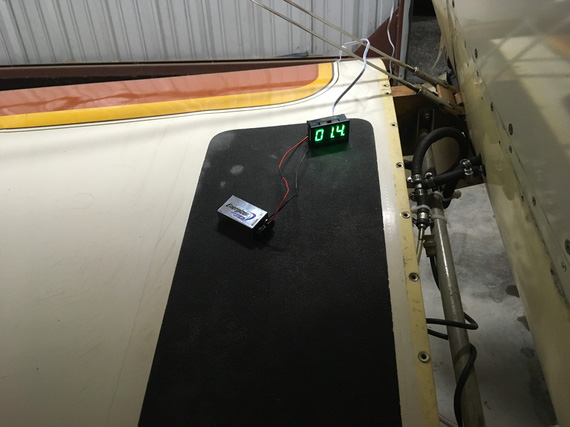
Rigged up
- Master On: 1.5 amps
- Includes: Master Solenoid, and a couple of gauges
- Fuel Pump: 0.2 amps
- "Radios" switch (turns on engine monitor, and power to radios: turning backlighting on them): 0.8 amps
- I-Com Radio, Transmit: 2.6 amps
- Intercom: 0.1 amps
- Transponder: 1.1 amps
- Smoke Oil pump: 2.2 - 2.6 amps (high on startup)
So couple interesting things here. I think the x-der number is too low, but it wasn't being interrogated, and I can't make it be interrogated without flying the plane or using a transponder tester which I don't have. Also, Master On is too high seemingly... Will need to double check later and isolate things (master solenoid, hobbs, voltmeter, voltage regulator, fuel gauge) if I care enough - I don't think I do. Also, fuel pump is too low seemingly. Need to double-check the spec.
And then, I could not turn on the Turn-Slip Indicator...
Turn-Slip Indicator
Sad, sad indicator... see, it's long. And it's wire connector is sticking out. And it's right behind the front seat's headrest, and there's just not enough room for it, and the connector.
So whomever put it in... did this:
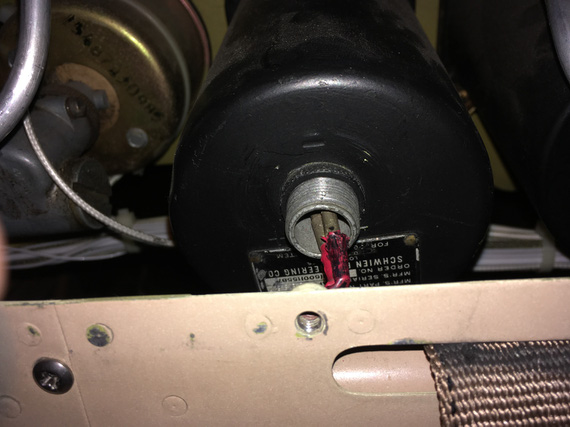
Sad, sad wiring
It's hard to see; but basically, those wires are bent "down" at a very sharp 90 degrees angle. Notice how he just used pins without the actual connector. The distance between them is tiny! I am surprised they haven't shorted over all these years. I really am.
Initially, I thought the gauge didn't turn on because that wiring was all bust up, so to test it, I decided to pull it out.
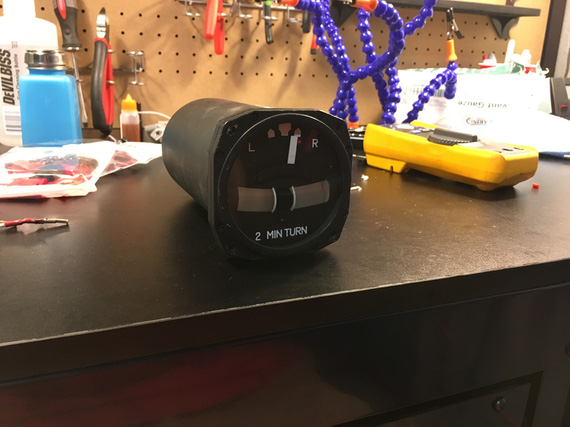
On the bench
I cut off the wires with those pins on them to hook it up to my testing battery... hmm.. but I needed some leads! Well, I was gonna make a bunch of various test leads - so this is as good a time as any! Man, I love soldering...
I long decided to make a bunch of leads with "passthru" banana plugs on one end, and something (a crocodile clamp, a battery clamp, a ring terminal) on the other. This way, I could mix and match, and plug them into my multimeter; daisy chain, and have multiples depending on what and how I needed to hook up. I had all the bits (clamps, crocodiles, banana plugs), and even got a roll of very nice super flexible silicone coated probe wire.
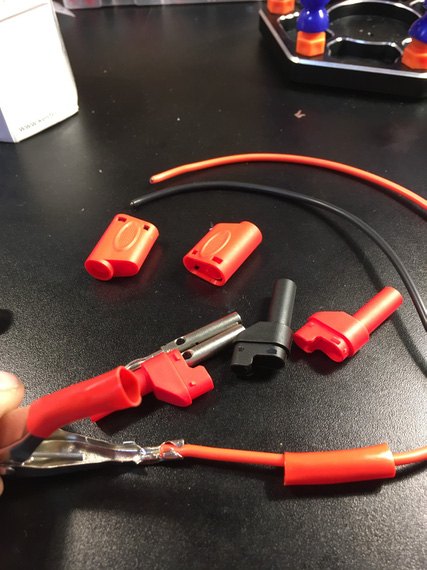
Components, and the battery clamp crimped on
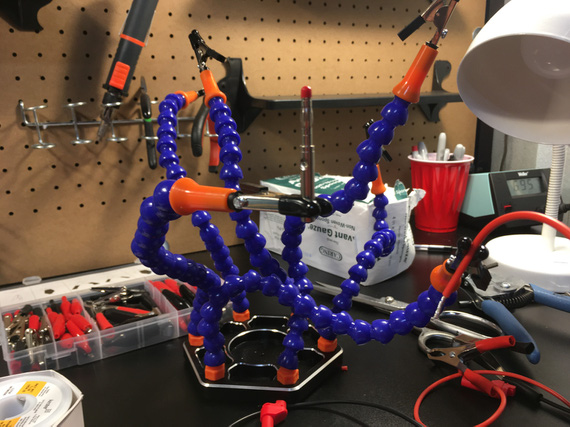
Release the Soldering Kraken!
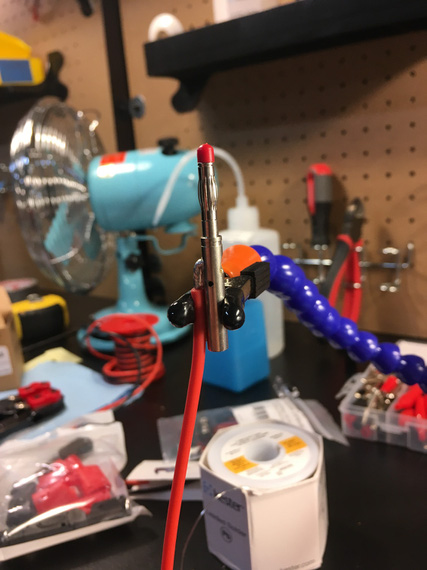
The banana plug pin
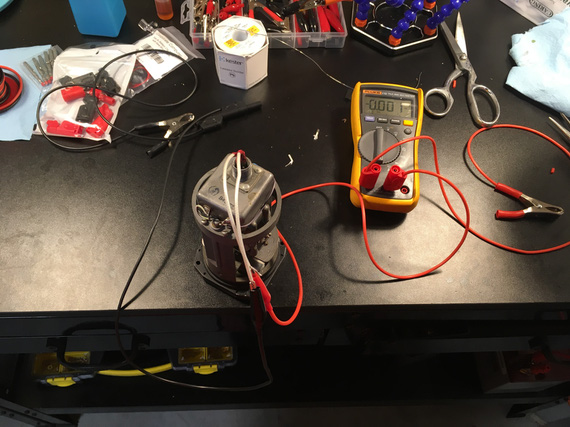
All hooked up
The gyro in the gauge didn't start. Damn.
But I had resistance between + and -. And I had voltage! Hmmm..
Second time I hooked it up, I saw a bit of a spark when I put the positive clamp to the battery, and heard something.
I spun the gyro with my finger.... it spun up!
Well, well. So that gyro "froze" in a bit... Yep, it was hard to turn over with a finger - no doubt a small motor in there had a hard time!
I probably "cleared it up" a bit when turning it over with my fingers - but that won't last long... damn.
Are we looking at the overhaul for this thing too now? Sigh.... Maybe I can find parts to do that myself, but not so sure about that.... It's not common for owners to overhaul their instruments - they're precision clockwork, after all...
Oh well.
And I will have to figure out how to solve that wiring problem with no space to hook up the right type connector. I am thinking along the lines of maybe routing a wire from inside of the gauge down thru a hole I'd drill, a grommet it it, and covering the whole business with with some sealant or something, so that the dust doesn't get in. we'll see. Need to ponder this a bit more.
Young man, was that a landing or were we shot down?
Up ↑
The Flying Fire Hazard
...sparks galore!
| On: | May 16, 2019 |
| In: | [Chickenhouse Charger] Electrical Rebuild |
| Tags: | 6781G, MA5 Charger, Annual, electrical |
This thing nagged me for a while. The Charger did not have the Field breaker. For that matter, it didn't have the Alternator master breaker, either.
It had this weird "main buss" breaker for 60 amps, but that didn't look like the Alternator breaker to me.
So in between dealing with other things after having decided to put her thru Annual in 2019 a bit early, I was running around with my multimeter, tracing wires.
Initially, I quickly discovered that some lines were definitely not fused; like Battery -> Main Buss line, and thought I'd put inline fuses into them, and be done.
She has an old charging system; a mechanical switching voltage regulator, and a Delco Remy alternator seemingly from a tractor:
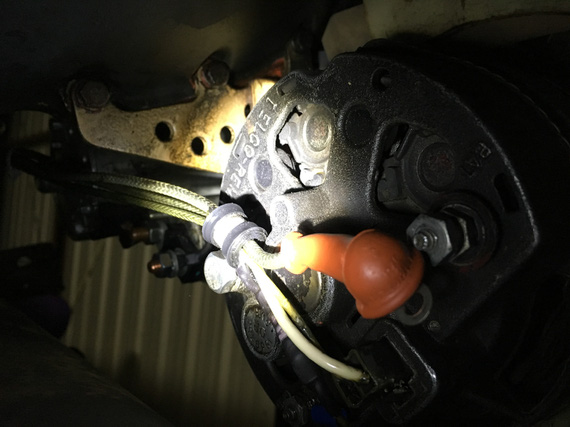
The old Delco-Remy
Voltage regulator didn't make sense. It had 4 wires (should be 2: supply and field output, or 3: supply, sense, and field output).
Alternator didn't make sense. Instead of 1 wire for Field input, it had two wires.
Additionally, Battery Contactor didn't make sense. One terminal had a wire going to it. The other was grounded....
Interlude
Battery Contactor is an interesting point here. Normally, one terminal is connected to the "always hot" side of it (basically, directly to the battery) and the other goes to the Master Switch. Master Switch turns the Battery Contactor on by grounding that wire, providing the negative side to the circuit. It's a safety thing. If that wire breaks, it'll either turn the electrical off (open circuit), or it will keep it turned on (short to ground). That's it.
But, one of the terminals on the Battery Contactor was grounded... that means, that the other terminal (the wire coming from the Master Switch) must provide positive side??? Huh? But where does it get it's power from?
Tracing
So to tracing we went. I spend maybe 10 hours trying to find diagrams and understand that alternator and voltage regulator hookups.
And me tracing it spelled my doom.
The Diagram
Now, I didn't trace the rest of it. Just the main distribution system. That was enough.
Shall we?
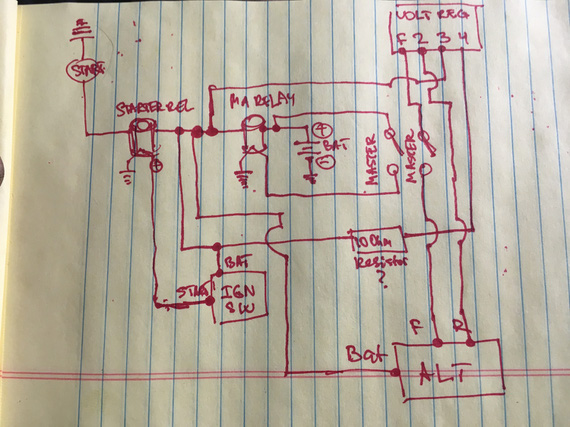
The current main power system of the Charger
Yep, the diagram is missing the main power buss. It's dangling off of the same spot where everything else that's interesting is - the Battery Contactor (marked MA RELAY) <-> Starter Contactor (marked STARTER REL) link.
So let's see what we have here.
- Lots of unfused wires. Do you see a single fuse here? Nope. That's because there aren't any. All the fuses are further downstream, off of the main buss.
- Voltage Regulator has this extra wire running to / from cockpit that isn't really necessary and could've been kept on the hot side of the firewall (terminal 4 wire)
- Alternator field broken at output (F->ALT) rather than at input (battery -> terminal 3)
- And the best part? Always hot wire that you can't turn off between the battery and the Master Switch to turn the Master Solenoid on.
That last bit bugged me. I couldn't find the damn thing. Even before actually tracing it, I knew that if the Master Solenoid is switched on the "hot" side, it needs to get the power from somewhere, and that only could be battery. But I didn't see any wires on the always hot side of the Master Solenoid. Only when I traced it, I actually traced the physical wire to where it goes, and then found it. It was so tucked behind the battery -> Master Solenoid wire that it was invisible:

This little !@#!S@#....
Oh; and by the way, the Master Switch is the only switch that's soldered in, and w/o any good insulation around the terminals, and over-stripped wires. So that's just waiting to short, and the magic smoke that'll be let out behind the panel when that shorts can't be stopped (always hot wire, remember?)
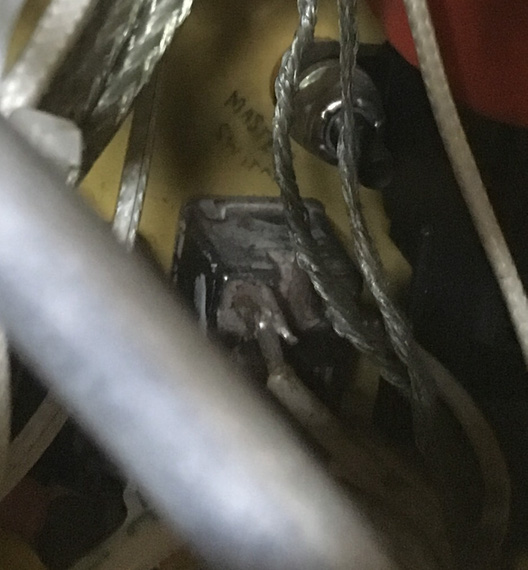
Master Switch
The Wires
So I kinda went backwards here; but I thought it'd be easier to see the diagram first.
Let's see.
Most of connections are made on this very nicely marked terminal block:
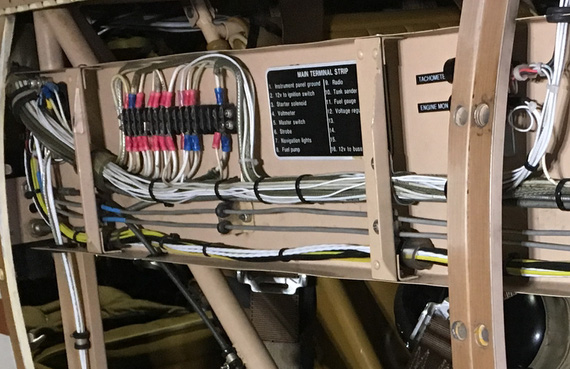
The terminal block
All the switched power comes out there, and every wire is marked. This actually helped a lot in tracing. This block is on the side of the plane, right next to the front hole's backrest.
You know what threw me off the most with that damned always hot wire (I ended up tracing it physically)? It's how it's hooked up.
Yep, it is hooked up to that terminal block. To the terminal... that is marked.. (drumroll).... "Master Switch".
Wait.. this actually makes sense... But where's the "return" from the switch?
Ah! It's the wire that's marked.... drumroll... "Fuel Gauge"!
So really, let's look at what's going on, shall we? Zoom in the image below, it's annotated.
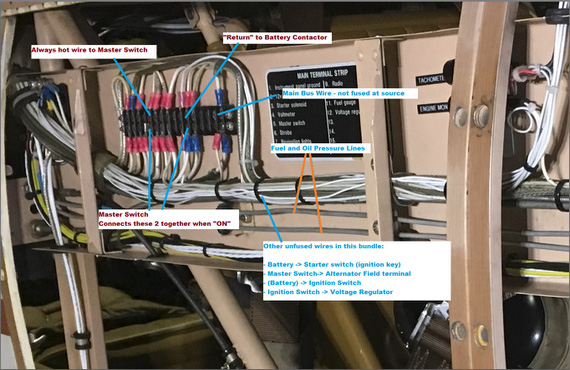
Untangled
So let's see. We've got this bundle of wires, a lot of which are not fused, and one of which is always hot.
The Main Buss wire is the thickest one (10 gauge maybe?) that's not fused between this buss bar and the source (engine compartment).
Oh, did I mention that this buss bar is on the side of the plane near the rear instrument panel (so that 10 gauge run, and the rest of the harness between firewall and the panel is about 30 inches long)?
What else do we see there? Oh! The two little 1/16inch thick aluminum lines carrying.. fuel pressure (and oil pressure).
Shall I say more?
Shall I say that there's a fuel tank in between the front hole (passenger) and the firewall?
That the wires run along between firewall and rear cockpit along that fuel pressure line (to fuel pressure gauge)?
That if one shorts to this very nearby fuel pressure line, it'll burn a hole straight thru it, and then ignite the gas that'll start coming out?
Yep.
Can I fix all of that?
Sure. But rewiring will be much much easier, because I have to touch pretty much everything. Re-running half of individual wires in a bundle is much harder than re-running them all.
So, I made a decision to rewire the plane... Sigh. Looks like I won't be flying for a looooong time.
Oh, and tell you what. Tracing wires on a biplane is dangerous. I ended up twisting my knee and pulling a muscle while trying to get behind the panel so badly that I couldn't walk (or sit) for 2.5 days :(.
Navy carrier pilots regards Air Force pilots:
“Flare to land, squat to pee.”
© Copyright "79FT". All rights reserved. Feel free to cite, but link back to the pages cited.
This website only shows how I did things in my various projects. These pages are for information and personal entertainment only and not to be construed as the only way, or even the perceived correct way of doing things. You are responsible for your own safety and techniques.
